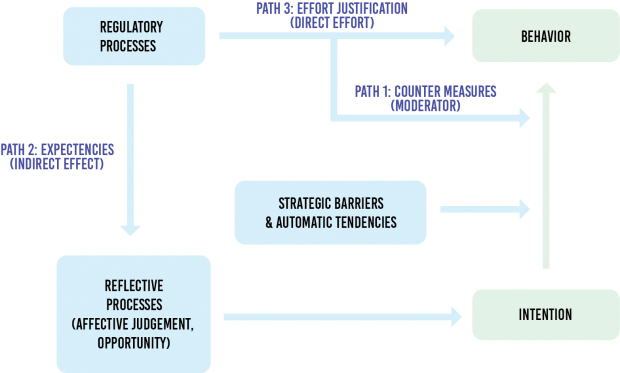Intention-Behavior Discordance: What is happening (see Rhodes et al., 2021)?
Figure 1 provides a conceptual diagram for intention-behavior discordance in PA, based on M-PAC which highlights strategic factors and automatic tendencies as the most likely determinants.
Strategic challenges comprise determinants that prohibit the long-term execution of intention-behavior relations. In M-PAC the two critical strategic failures include outcome vs. behavioral goal confusion and failure to consider multiple goals. Confusion between outcome and behavioral goals are intentions that are linked to the desired long-term outcomes of PA, rather than the behavioral experience. Evidence suggests that intentions to engage in PA formed on the basis of long-term benefits are likely to fail compared to those less common individuals who form intentions based on the behavioral experience itself. A focus on one specific intention is likely to under-estimate complex goal-directed actions. Juggling multiple goals is one of the prime reasons for why new intentions are forgotten during action control phase and may also contribute to unrealistic, fanciful intentions, which are far less likely to be fulfilled. Overall, the evidence strongly indicates that lack of consideration of one’s multiple intentions will increase failure in action control.
Automatic Tendencies affect the translation of intentions by more impulsive, situational or abrupt determining factors. The first determinant is based on the premise that people have a basic underlying tendency to approach experiences that are pleasant and avoid experiences that are unpleasant. Negative experiences during PA may be acting as an underlying restraining force that counteracts positive intentions Overall, there is likely a basic tendency for us to avoid PA, and thus disrupt action control, in situations where we have had unpleasant past experiences or negative incidental affect. The second tendency is based on the tenet that humans have an underlying urge to minimize metabolic costs. From an action control perspective, this would suggest that fulfilling PA intentions that do not involve necessity (e.g., exercise) are likely to be met with an underlying avoidance, because it represents unnecessary energetic cost

Figure 2 details three paths for how regulation processes may work upon PA action control. Specifically, regulation processes assist in the selection of the intention and act as counter-measures against deselection (Path 1). Path 2 represents the effect that regulatory processes may have on intention via re-setting expectations and thus making the intention pragmatic. Finally, path 3 represents the effect that behavioral regulation can have on PA as a motive unto itself through effort justification of the time and energy involved in these regulatory behaviors.
Figure 3 details how reflexive processes may coordinate to affect sustained action control. Identity in the role of action control may have three paths of influence. The primary path (Figure 3 path 1) is likely a selection bias that assists in the enactment of planned PA. Essentially, those with a PA identity are probably more attuned to seize opportunities to be active and thus fulfil their intentions. Thus, identity acts as a kind of automatic tunnel vision toward action control. Identity may also augment PA through more impulsive motivation independent of action control and regulatory processes (see Figure 3 path 2). The third path is the role identity may play back into the regulatory processes system (see Figure 3 path 3). The motivation produced to reduce discordance (between an identity standard and observed behavior) is likely focused upon bolstering regulatory processes in order to fulfil PA intentions.
Habit in M-PAC assists primarily in creating a tunnel vision toward enacting the intention and thus shields from automatic tendencies that may constrain PA intention translation (See figure 3 path 1). This is not to say that habits cannot assist in PA execution or additional PA behaviors beyond the initial intention (see Figure 3 path 2), but the primary expected determination of habits in M-PAC is through the instigation path as a form of selection bias toward intended action.


